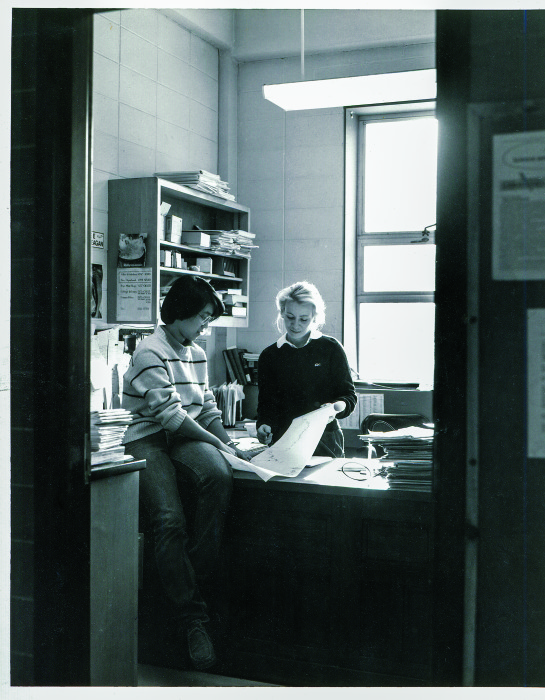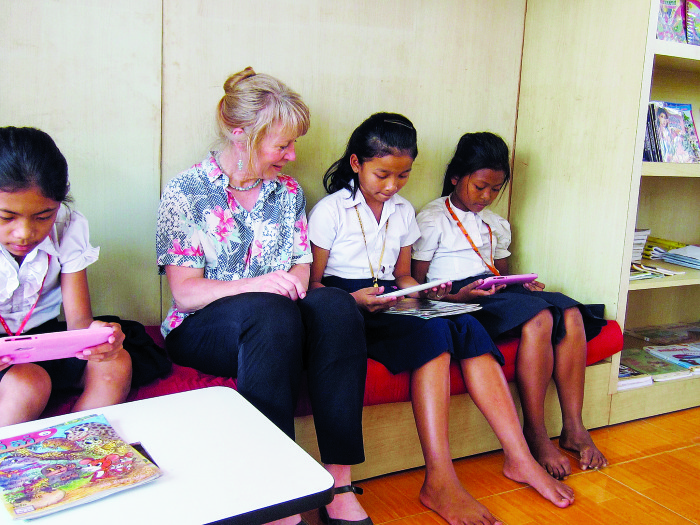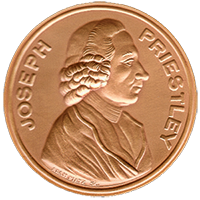Advertisement
I am enormously honored and humbled to stand here tonight as the 2018 Priestley Medalist. It takes a scientific village to win this coveted award, and the most important members of my village are my family: my physicist husband, Steve Kevan, whom I met my first day of graduate school and has since given me his endless support, and our awesome sons, Bryan and Dustin.
Being here tonight is such an unlikely destination when I consider where my journey began. In my early years, growing up on a farm in Kansas, I wasn’t even aware of a career in science, let alone that I could aspire to it. Still, my parents both dreamed that my three sisters and I would someday be college graduates, a goal they never reached because of the hardships of the Depression.
To raise our family, my father took on the task of farming while my mother was the local beautician, working in a playhouse-sized shop that you could see outside our kitchen window. Eventually, we moved to Lindsborg, Kan., where my parents opened a combined beauty salon and clothing store. Once my oldest sister reached college age, my mom and dad took another big gamble and moved their business to Manhattan, the home of Kansas State University, giving all of us the opportunity for college while still keeping us close by so we could all help out at the shop. Time and again, my parents took risks, sometimes risking all, to better our lives, and that has been a powerful and driving lesson for me.
Advertisement
Memories of my mother, Lucille, and my maternal grandmother, Tilly, continue to be a source of inspiration, not to mention entertainment. Like me, my mother also had no concept of a science career, yet she was the first person to introduce me to chemistry, pointing out elements in the hair-product labels that were on the periodic table. Her computational skills rivaled a pocket calculator’s, and she always encouraged me to do well in math as a pathway to a good job. I admired my mom’s resourcefulness as an entrepreneur, even though some of her ideas were a bit wacky. Among my favorites of her creations were curlers decorated with tiny plastic flowers to make women more attractive when wearing their curlers in public and Comfy Tabs to allow women to sleep comfortably in their curlers. My grandmother Tilly was also a wonderful role model as a woman of independence and self-sufficiency. After her husband died, she became the toast of the town—figuratively and literally—when she opened her own liquor store in Salina, Kan., after it went “wet” in 1948.

The first turning point in my life’s trajectory arrived in an eighth-grade geometry class. By then I realized I was good at math, and when I scored well in math aptitude tests, a school counselor told me that I would make a good secretary. But one day in geometry, my teacher, Don Schmalzried, watched me successfully solve a problem in a way he hadn’t taught, and his praise sparked something in me. At that moment, those words offered me enough encouragement to think I was capable of something beyond secretarial work, even though I had no idea what that would be.
Mr. Schmalzried’s further encouragement in high school steered me toward my intellectual strengths in the midst of all those insane adolescent social pressures. When I finally arrived at Kansas State University in 1971, I was a committed math major. But by my sophomore year, I discovered that the analytical gifts I’d applied to math were serving me just as well in chemistry. As my fascination with scientific questions grew, I realized the chemistry field also offered something else: the opportunity to do research. It was an easy decision to switch majors, and I was soon conducting analytical chemistry research in Cliff Meloan’s laboratory and organic chemistry research in Mike Hoffman’s laboratory. But I found my real home in Don Setser’s physical chemistry laboratory, which I shared with his graduate students, Bert Holmes and Paul Marcoux.
The chemistry department head, “Wild” Bill Fateley, showed me the power of a simple introduction when he put me in touch with George Pimentel, who soon would become my graduate adviser at the University of California, Berkeley.
For my doctoral research project in the Pimentel laboratory, I built a chemical laser to examine the high rotational states of HF produced by the photoinduced reaction of hydrogen with ClF. George was away at the National Science Foundation in Washington, D.C., for all but a few months of those years. Still, I learned so much from him, not only from his regular communication but also from his absence, which helped me develop the self-reliance and independence that my grandmother had first modeled for me. George’s willingness to take on the NSF role also taught me the importance of giving back to the community.
After my husband and I earned our doctorates in 1980, we headed east. He went to work at Bell Laboratories, and I was intent on pursuing my combined love of teaching and research as the first female tenure-track faculty member in chemistry at Bryn Mawr College. In addition to honing my teaching skills, I assembled a talented group of undergraduate and graduate students who helped me build a laser laboratory and launch my own research program. As much as I loved my years at Bryn Mawr—especially the collegiality of Charles Swindell and Frank Mallory—I eventually realized a research-intensive university was a better place for my long-term career aspirations.

In 1985, the University of Oregon came calling for both my husband and me, in our respective fields, and the campus has been an ideal fit in so many ways. In my 32 years there, I have never failed to be delighted by the quality of graduate students and postdoctoral associates whom the university attracts. I also am eternally grateful to the university for the incredible support and flexibility it has provided me.
Over the years, most of our studies have focused on understanding bonding and adsorptive processes at water surfaces in contact with air, atmospheric pollutants, and oils. From our early surface spectroscopic studies, we obtained detailed measurements of the molecular structure and orientation of soaps and surfactants as they adsorb at both air-water and oil-water interfaces and how this adsorption affects the behavior of surface water molecules.

As the complexity and desire for more detailed molecular information grew, we augmented our experimental studies with theoretical methods. This combined approach greatly accelerated our understanding of the molecular characteristics of these liquid interfaces, with a particular focus on surface water molecules at neat air-water and oil-water interfaces. One of our most exciting discoveries contradicted the prevailing view that oil and water molecules would avoid each other at oil-water interfaces. Instead, we found evidence for a weak bonding interaction between interfacial water and oil that creates a unique molecular structure. Further studies showed how this interfacial structure influences the adsorptive properties of ions, surfactants, polyelectrolytes, and even peptoid nanosheets. Our most recent studies explore these effects at spherical nanoemulsion surfaces. Studies of the adsorption of atmospherically relevant molecules continue to be the focus of our air-water surface studies.
Throughout my career, I have been committed to increasing the number and success of women in science. This passion grew from an unexpected source: a Sex and Politics course that I took just to satisfy an undergrad requirement. Far from what I expected from its juicy title, I received a bracing introduction to the gender-related challenges that working women face in male-dominated fields. It was the consciousness-raising lesson that I needed then and for all the years to follow.
The lesson especially came to the fore in the late 1990s as I was ascending at Oregon through the promotion process. Increasingly, I heard stories from other women chemists who were suffering gender inequities at midcareer—a time one might think such experiences would be waning. This was before the infamous MIT report on this issue. With the help of Jeanne Pemberton and seed funding from the Dreyfus Foundation, I joined forces with nine other senior women chemistry faculty to form COACh, an organization that aimed to address the barriers that were so evident to all of us in our field. Over time, we launched a series of career-development workshops on negotiation, leadership, and communication techniques to empower women in academia, industry, and beyond to be more strategic in their chemistry careers. Eventually, we expanded our scope to all the sciences and engineering, and we added workshops on mentoring, career balance, and entrepreneurship.
The success of COACh has far exceeded any of our expectations. To date, over 20,000 women across all scientific and engineering disciplines have participated in our workshops at universities and professional settings across the country. Our social science research team surveys and documents the impact of our programs on participants, and their stories of aspiration and achievement often reduce me to tears. In 2012, we began taking COACh programs abroad with a focus on scientists in developing countries. This work has allowed me to reach out to hundreds of scientists—both male and female—in over two dozen countries in Africa, Southeast Asia, the Middle East, and Latin America. I am especially appreciative of the funding agencies that have supported COACh over the years, as well as my assistant, Priscilla Lewis, who keeps the operation humming and is the essence of our mantra to be “relentlessly pleasant” in the face of all adversity.
Between teaching, research, and my other professional responsibilities, I am here to admit to you my biggest career failure: my inability to say no. This failing has been most apparent in the last five years with the coincidence of the American Association for the Advacement of Science presidency, the National Science Board appointment, the U.S. State Department science envoy appointment, and the expanded international COACh activities. There are no regrets, however, because this whirlwind has given me an invaluable perspective on the global scientific enterprise, and I’d like to share some of these insights with you.

First, I am in awe of the incredible impact that so many scientists are making in developing countries with limited resources. It is my hope that we not minimize the accomplishments of these gifted individuals with our reliance on simplistic metrics such as publication numbers, impact factors, and h-indices. Second, I look forward to the day when we hold a multitude of critically important scientific careers in the same regard as we do professorships. Today, we need scientific talent in a vast array of occupations outside of academia to keep the world’s scientific enterprise afloat. Such choices need more credit and visibility. Expanding our definition of the scientific community, I believe, serves to enrich us rather than dilute us.
And third, as we celebrate the largest number of female national award recipients in the history of ACS, we also must recognize that we have far to go in embracing and empowering all who seek scientific careers regardless of race, religion, social status, gender identification, and physical disability. Although social diversity may sometimes make us uncomfortable, it is proven that discomfort can push us to work harder and be more creative in our problem solving.
As I look back on my career, I take great pride in my research accomplishments, but I realize that I have found my deepest fulfillment in the human interactions. My life is rich beyond measure from the mentors who have shared their gifts with me, the colleagues who have expanded my capacities, and the students and postdocs who have taught me as I’ve worked to guide them. I am constantly inspired by the spirit of the people I have met through COACh who prove time and again the power of courage and creativity. It’s easy for us to get lost in the complexities of our work, but it’s important to remember that we can’t succeed without one another. Our human connections are crucial to making great science.
Finally, I want to acknowledge it’s not lost on me that I’m not the typical recipient of this award, which, of course, is evident from my background, my forays far beyond the laboratory, and most obviously, my gender. I am profoundly grateful to all who have been a part of placing this beautician’s daughter here at this moment. Because of you, I hold the hope that my selection is an important step toward making it typical—and that it serves as a welcome sign to the diversity of humanity that science has such ability to attract.

